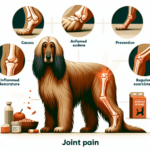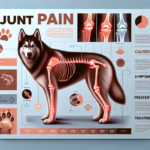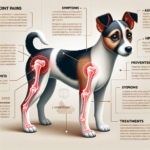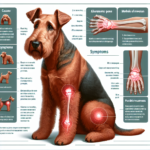Lancashire Heeler Joint Pain: Causes, Symptoms, Prevention, and Treatment
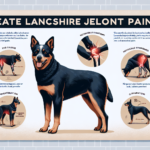
Introduction
The Lancashire Heeler is a small, energetic breed known for its herding abilities and cheerful disposition. Originating from the United Kingdom, this breed was initially developed to herd cattle and control vermin on farms. Despite its small size, the Lancashire Heeler is robust, agile, and highly intelligent, making it a versatile working dog and a delightful companion.
Like many breeds, the Lancashire Heeler is prone to certain health issues, with joint pain being a significant concern. Joint health is crucial for maintaining the breed’s active lifestyle and overall well-being. Understanding the causes, symptoms, prevention, and treatment of joint pain in Lancashire Heelers can help owners ensure their pets lead healthy, pain-free lives.
Breed-Specific Joint Pain Risks
Genetic Predisposition
The Lancashire Heeler has a genetic predisposition to several joint-related issues, including hip dysplasia, elbow dysplasia, and arthritis. Hip dysplasia occurs when the hip joint does not fit into the hip socket properly, leading to pain and mobility issues. Elbow dysplasia involves abnormal development of the elbow joint, causing lameness and discomfort. Arthritis, a common condition in older dogs, results from the degeneration of joint cartilage, leading to inflammation and pain.
Age-Related Risks
As Lancashire Heelers age, the risk of developing joint pain increases. While young dogs may show early signs of joint issues due to genetic factors, older dogs are more likely to experience arthritis and other degenerative joint conditions. Owners should be vigilant about their dog’s joint health as they approach middle age, typically around 5-7 years old, and continue monitoring into their senior years.
Activity Level and Joint Stress
The Lancashire Heeler’s high energy levels and working background mean they are often very active. While regular exercise is essential for their overall health, excessive or inappropriate activity can put undue stress on their joints. Activities such as jumping, running on hard surfaces, or intense play can exacerbate joint issues, especially in dogs with a genetic predisposition to joint problems.
Common Symptoms of Joint Pain in Lancashire Heelers
General Symptoms
- Limping: One of the most noticeable signs of joint pain is limping or favoring one leg over another.
- Stiffness: Dogs with joint pain may show stiffness, especially after resting or during cold weather.
- Reluctance to Move: A dog experiencing joint pain may be hesitant to engage in activities they once enjoyed, such as running, jumping, or climbing stairs.
- Swelling: Inflammation around the joints can cause visible swelling.
- Behavioral Changes: Dogs in pain may become irritable, less active, or show signs of depression.
Breed-Specific Symptoms
In Lancashire Heelers, joint pain may manifest as a reluctance to herd or perform tasks they previously enjoyed. Owners may also notice a decrease in their dog’s agility and willingness to participate in high-energy activities. Given the breed’s typically cheerful and active nature, any significant change in behavior or activity level should be taken seriously.
When to Consult a Vet
If a Lancashire Heeler shows any signs of joint pain, it is essential to consult a veterinarian promptly. Early diagnosis and intervention can prevent further deterioration and improve the dog’s quality of life. Owners should seek veterinary advice if their dog exhibits persistent limping, stiffness, swelling, or behavioral changes.
Preventive Measures for Joint Health
Exercise Recommendations
Regular, moderate exercise is crucial for maintaining joint health in Lancashire Heelers. Activities such as walking, swimming, and controlled play can help keep joints flexible and muscles strong without causing excessive stress. Owners should avoid high-impact activities like jumping or running on hard surfaces, which can exacerbate joint issues.
Dietary Suggestions
A balanced diet rich in essential nutrients can support joint health. Foods containing glucosamine, chondroitin, and omega-3 fatty acids are particularly beneficial. These nutrients help maintain cartilage health, reduce inflammation, and support overall joint function. Owners may also consider supplements specifically designed for joint health, but it is essential to consult a veterinarian before adding any new supplements to the dog’s diet.
Weight Management
Maintaining a healthy weight is critical for reducing joint stress in Lancashire Heelers. Excess weight puts additional pressure on the joints, exacerbating pain and increasing the risk of developing joint issues. Owners should monitor their dog’s weight and adjust their diet and exercise routine as needed to ensure they remain within a healthy weight range.
Early Screening and Monitoring
Regular veterinary check-ups and early screening for joint issues can help catch problems before they become severe. For Lancashire Heelers, screening for hip and elbow dysplasia is particularly important. Early detection allows for timely intervention, which can significantly improve the dog’s quality of life and prevent further joint damage.
Treatment Options for Joint Pain
Non-Surgical Treatments
Non-surgical treatments for joint pain in Lancashire Heelers include medications, physical therapy, and lifestyle adjustments. Anti-inflammatory drugs and pain relievers can help manage pain and reduce inflammation. Physical therapy, including exercises and massage, can improve joint mobility and strengthen supporting muscles. Lifestyle adjustments, such as providing a comfortable bed and avoiding high-impact activities, can also alleviate joint pain.
Surgical Options
In severe cases, surgical intervention may be necessary to address joint pain. Common surgical options include hip replacement, arthroscopy, and joint fusion. These procedures can significantly improve the dog’s mobility and quality of life. However, surgery should be considered a last resort after exploring all non-surgical options.
Alternative Therapies
Alternative therapies such as acupuncture, hydrotherapy, and massage can provide additional relief for dogs with joint pain. Acupuncture involves inserting thin needles into specific points on the body to relieve pain and promote healing. Hydrotherapy, or water therapy, allows dogs to exercise without putting stress on their joints. Massage can help reduce muscle tension and improve circulation, providing relief from joint pain.
Lifestyle and Management Tips
Daily Care Routine
A consistent daily care routine can help manage and alleviate joint pain in Lancashire Heelers. This routine might include gentle exercise, a balanced diet with joint-supporting nutrients, and regular veterinary check-ups. Owners should also monitor their dog’s weight and adjust their care routine as needed to ensure optimal joint health.
Modifying the Home Environment
Making the home environment more comfortable for a dog with joint pain can significantly improve their quality of life. Consider using ramps instead of stairs, providing orthopedic beds for better support, and ensuring that food and water bowls are at a comfortable height. These modifications can reduce joint stress and make daily activities easier for the dog.
Long-Term Management
Long-term management of joint pain involves ongoing monitoring and adjustments to the dog’s care routine. Regular veterinary check-ups, weight management, and appropriate exercise are crucial. Owners should also be prepared to make lifestyle changes as their dog’s condition evolves, ensuring they remain comfortable and active despite joint pain.
FAQs About Lancashire Heelers and Joint Pain
What are the early signs of joint pain in Lancashire Heelers?
Early signs of joint pain include limping, stiffness, reluctance to move, and behavioral changes such as irritability or depression. Owners should monitor their dogs for these symptoms and consult a veterinarian if they notice any changes.
Can joint pain in Lancashire Heelers be prevented?
While genetic predisposition cannot be changed, joint pain can be managed and minimized through regular exercise, a balanced diet, weight management, and early screening. Preventive measures can significantly reduce the risk of developing severe joint issues.
Are there specific exercises that are better for Lancashire Heelers with joint pain?
Low-impact exercises such as walking and swimming are ideal for Lancashire Heelers with joint pain. These activities help maintain joint flexibility and muscle strength without causing excessive stress on the joints.
What dietary supplements are recommended for joint health in Lancashire Heelers?
Supplements containing glucosamine, chondroitin, and omega-3 fatty acids are beneficial for joint health. These nutrients support cartilage health, reduce inflammation, and improve overall joint function. Always consult a veterinarian before adding new supplements to your dog’s diet.
When should I consider surgery for my Lancashire Heeler’s joint pain?
Surgery should be considered a last resort after exploring all non-surgical options. If your dog’s joint pain is severe and significantly impacts their quality of life, consult a veterinarian to discuss potential surgical interventions.
Conclusion
Joint pain is a significant concern for Lancashire Heelers, but with proper care and attention, it can be managed effectively. Understanding the causes, symptoms, prevention, and treatment options is crucial for ensuring your dog’s joint health. Regular veterinary check-ups, a balanced diet, appropriate exercise, and weight management are essential components of a comprehensive joint health strategy. By taking proactive measures and consulting with your veterinarian, you can help your Lancashire Heeler lead a happy, active, and pain-free life.

